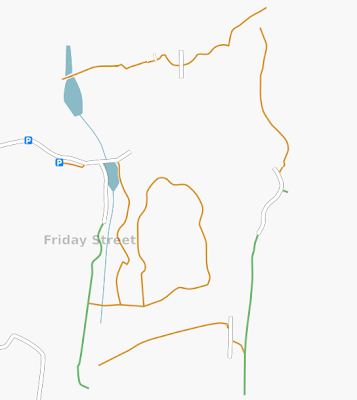So what do we do to develop this countryside map?
Let's start by going on a typical walk with an OpenStreetMap surveyor. Using a GPS to record where you walked, a notepad and camera to record what you see. After you get back and edit the area, you end up with something like this:

(actually that was two walks). It's not very impressive is it? Would you publish that, or use it when walking? For comparison,
this is how the OS show that area.
(Google doesn't care of course - if you can't drive on it, they don't show it. So it's only OS and harveys to compete against)
Notice the stubs of road or path, where you see a route but don't follow it. You get a lot of those while walking, because it's actually quite difficult to follow every path in an efficient way.
There's a difference here between city and country. In the city, (a) you have bikes, which are about 5x as efficient as pedestrians for mapping, (b) are more likely to have good aerial photography available, and most importantly (c) the grid of streets is usable on its own as a complete map, without having to care about the features inbetween.
In the country, a map showing only rights-of-way isn't really good enough, as the image above shows. It doesn't give you any feel for the terrain, it doesn't show you what to expect, and if you get lost, the map is of no help because it doesn't show any points of interest.
So what can we do to improve it?
(1) Contours are good, although only NickW seems to be developing these at the moment, and only for a very small part of the country.
Maybe we should have a tileserver serving transparent contours for the whole country that can be overlaid on any map?
(2) Forests, woodlands, and lakes. I know we're starting to do these and they appear on the map, which is good, from aerial photos.
There doesn't seem to be any one project to systematically go through satellite and aerial photos of an area and mark visible features on the map. If some people sketched out these features for their local national park (in the same way as Dave Groom and others have done for Baghdad) that might give interesting results.
(3) More visible features. What does it take for hedgelines and lone trees to show-up in our maps? Can we mark ridges? Farms? Viewpoints? Gulleys, ledges, craters and other small -scale terrain features? Why can't we add arbitrary labels to the map, showing things like reservoirs, fords, steps, bike hire, drinking water taps and toilets, cafes, stiles, symbols for pubs which serve food -- let them all appear on the map as labels _while_ we debate what official tagging scheme and rendering icons to use for them.
We still can't even differentiate between a cornfield and a cowfield. "landuse=farm" for both of them. Without fixes like that, it's going to be difficult to plan a walk in OSM, or to correlate the printed map in your hand with the view you're looking at.
(p.s. it doesn't help that highway=footpath is completely invisible in OSM maps, and that nobody has converted them to the "new approved" tag scheme)
(4) Mapping parties. Subject for a different blog post I think, or perhaps one by NickW.


